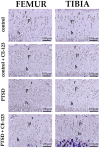Evaluation of PTSD-Induced Alterations in Bone Biomechanics and the Protective Potential of CE-123 in a Wistar Rat Model
- PMID: 40217875
- PMCID: PMC11989560
- DOI: 10.3390/jcm14072427
Evaluation of PTSD-Induced Alterations in Bone Biomechanics and the Protective Potential of CE-123 in a Wistar Rat Model
Abstract
Background/Objectives: Post-traumatic stress disorder (PTSD) has been associated with negative effects on bone health, potentially leading to reduced bone mass, altered geometry, and impaired mechanical strength. However, the extent of these changes and possible pharmacological interventions remains unclear. This study aimed to assess the impact of PTSD on bone properties and evaluate the therapeutic potential of CE-123 in mitigating PTSD-induced skeletal deterioration. Additionally, we examined the effects of CE-123 on healthy bone to determine its broader influence on skeletal integrity and growth. Methods: We conducted an experiment using female Wistar rats divided into four groups: Control, PTSD, Control+CE-123, and PTSD+CE-123. PTSD was induced using a validated stress paradigm, and CE-123 was administered to evaluate its effects on bone properties. Morphometric, densitometric, and mechanical parameters of the tibia and femur were analyzed, along with growth plate measurements to assess potential effects on skeletal development. Results: PTSD led to significant reductions in bone mineral density, bone mass, and mechanical properties, particularly in cortical thickness and relative bone weight, suggesting increased bone fragility. CE-123 treatment in PTSD-exposed rats prevented some of these adverse effects but did not fully restore bone integrity. In healthy rats, CE-123 increased bone length and growth plate size, particularly in the proliferative and resting zones, indicating a stimulatory effect on bone growth. Conclusions: PTSD negatively affects bone structure and mechanical strength, while CE-123 shows a potential to mitigate these effects. However, its influence on healthy bones raises questions about its long-term impact on skeletal development. Further studies are needed to evaluate CE-123's clinical applicability and safety, particularly in younger populations.
Keywords: chronic stress; dopaminergic modulation; femur; growth plate; tibia.
Conflict of interest statement
The authors declare no conflicts of interest.
Figures







Similar articles
-
Discordant recovery of bone mass and mechanical properties during prolonged recovery from disuse.Bone. 2013 Jan;52(1):433-43. doi: 10.1016/j.bone.2012.09.021. Epub 2012 Sep 24. Bone. 2013. PMID: 23017660
-
Infant cynomolgus monkeys exposed to denosumab in utero exhibit an osteoclast-poor osteopetrotic-like skeletal phenotype at birth and in the early postnatal period.Bone. 2014 Jul;64:314-25. doi: 10.1016/j.bone.2014.04.002. Epub 2014 Apr 13. Bone. 2014. PMID: 24727159
-
Deployment of personnel to military operations: impact on mental health and social functioning.Campbell Syst Rev. 2018 Jun 1;14(1):1-127. doi: 10.4073/csr.2018.6. eCollection 2018. Campbell Syst Rev. 2018. PMID: 37131363 Free PMC article.
-
[Posttraumatic stress disorder (PTSD) as a consequence of the interaction between an individual genetic susceptibility, a traumatogenic event and a social context].Encephale. 2012 Oct;38(5):373-80. doi: 10.1016/j.encep.2011.12.003. Epub 2012 Jan 24. Encephale. 2012. PMID: 23062450 Review. French.
-
Couple and family therapies for post-traumatic stress disorder (PTSD).Cochrane Database Syst Rev. 2019 Dec 4;12(12):CD011257. doi: 10.1002/14651858.CD011257.pub2. Cochrane Database Syst Rev. 2019. PMID: 31797352 Free PMC article.
References
-
- Messman T.L., LaPlena N., Wilensky S. Trauma-Related Disorders and Posttraumatic Stress Disorder. In: Friedman H.S., Markey C.H., editors. Encyclopedia of Mental Health. 3rd ed. Academic Press; Oxford, UK: 2023. pp. 501–510.
-
- Chen X. The Causes and Effects of Post-Traumatic Stress Disorder. SHS Web Conf. 2023;157:04029. doi: 10.1051/shsconf/202315704029. - DOI
-
- Palmer S.J. The Complex Neurology That Links Physical Health to Post-Traumatic Stress Disorder. Br. J. Neurosci. Nuesing. 2023;19:37–39. doi: 10.12968/bjnn.2023.19.1.37. - DOI
LinkOut - more resources
Full Text Sources

